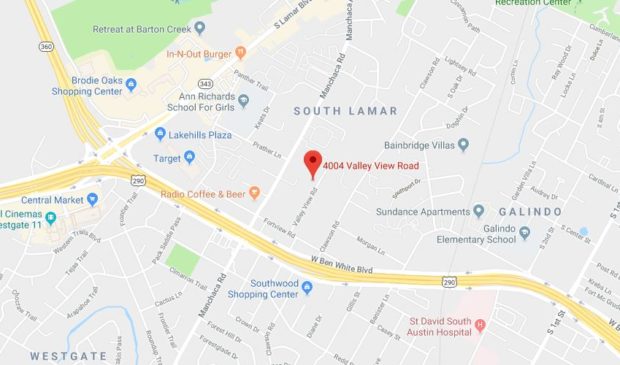Board of Adjustment says yes to South Lamar student housing
Wednesday, July 25, 2018 by
Ryan Young On July 9, the Board of Adjustment approved the construction of a small university dormitory in the South Lamar neighborhood, despite the concerns of some neighbors that the proposed facility could create parking shortages on a narrow neighborhood street.
The dorm would be located at 4004 Valley View Road and situated directly behind the Texas Health and Science University on Manchaca Road. THSU is an acupuncture school that teaches traditional Chinese medicine. The school wants to construct the dorm to provide housing for its foreign students, according to the variance application.
The property in question is very narrow and is currently home to a humble single-family house. Jim Wittliff, who represented THSU at the hearing, said the school had considered turning the house into a museum and library, but later backed off on those plans because of concerns about creating more traffic on Valley View. The proposed dorm would house 20 students in 10 two-bedroom apartments, each with a common area, refrigerator and microwave, but no stove, Wittliff said.
So what’s the holdup? The Land Development Code prohibits a “college or university site” on a street less than 40 feet wide – and Valley View Road is 25 feet wide. Board Member Bryan King said the rule is in place to ensure that fire engines can reach dormitories in a timely manner.
Some neighbors also say the high-density development doesn’t fit on a small neighborhood street.
Judy Lambert, who lives in a neighboring duplex, is concerned that building a dorm would make a bad traffic situation even worse. “There are no sidewalks,” she said. “Cars park on both sides of the street, which only allows for one-car passage … the load on the street adding in another high-density complex adds a lot of danger to what is already a tough situation.”
Although THSU expects the dorm’s residents to be foreign medical students, Lambert said the school “can’t promise that these people won’t have cars.” She also pointed out that the dorms might be converted to apartments in the future. If that ever happens, she asked, “Where are these people going to park?”
Wittliff said the dorm’s future residents will use alternative transportation, walking next door to class and using bicycles and buses to reach the rest of the city.
“It’s interesting that they’re doing Chinese acupuncture here, and many of their students are coming from China. I didn’t ever expect that to happen,” he quipped. “But they are coming here, and the ones that are coming historically do not drive cars. They either live very close by or they ride bicycles or buses.”
Wittliff then presented a letter Lambert had written in objection to the variance, and addressed her points: that the dorm would have no parking (Wittliff said there will still be 12 spaces, should the dorms ever become apartments), that students would double up in their apartments to save on rent (Wittliff said the university will prohibit this), and that the existing house would be torn down to construct the dorm (Wittliff said there is plenty of room to drive equipment around it).
“I think it’s a reasonable use,” Wittliff told the board, “and I hope you will approve it.”
The board seemed sympathetic to Lambert’s concerns about traffic. “I understand that people will certainly park in the street if they have cars, and there’s nowhere else. No doubt about it,” Chair William Burkhardt said.
“Fifteen or 20 years ago, when I was president of that neighborhood association, I used to deliver the newsletters up and down that street,” King said. “And that street is variable width all the way down. … you’re running a maze down there.”
“They have friends, and they have visitors, and you have different people with cars. You have deliveries,” Board Member Brooke Bailey said. “It’s just common sense that they might not own a car, but that does not mean that cars will not be on that property related to that dormitory.”
But the consensus was that 12 spaces should be enough to accommodate the dorm. So, Bailey put forth a compromise: approve the variance, but require the university to designate all 12 spaces for exclusive use by the dorm’s residents. And one of them will have to be for disabled users.
That motion was passed unanimously by the 10 board members who voted – including Don Leighton-Burwell, who was apparently more receptive to the dorm proposal compared to his “tear it down” position on a North Loop art co-op, another variance request that caused concerns about inadequate parking. King abstained, saying he had already consulted for Wittliff on the project.
Map courtesy of Google Maps.
The Austin Monitor’s work is made possible by donations from the community. Though our reporting covers donors from time to time, we are careful to keep business and editorial efforts separate while maintaining transparency. A complete list of donors is available here, and our code of ethics is explained here.
You're a community leader
And we’re honored you look to us for serious, in-depth news. You know a strong community needs local and dedicated watchdog reporting. We’re here for you and that won’t change. Now will you take the powerful next step and support our nonprofit news organization?









